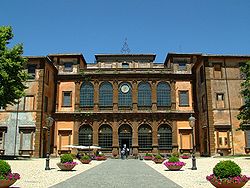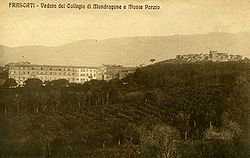
Villa Mondragone
Encyclopedia



Frascati
Frascati is a town and comune in the province of Rome in the Lazio region of central Italy. It is located south-east of Rome, on the Alban Hills close to the ancient city of Tusculum. Frascati is closely associated with science, being the location of several international scientific...
(Latium
Latium
Lazio is one of the 20 administrative regions of Italy, situated in the central peninsular section of the country. With about 5.7 million residents and a GDP of more than 170 billion euros, Lazio is the third most populated and the second richest region of Italy...
, central Italy
Italy
Italy , officially the Italian Republic languages]] under the European Charter for Regional or Minority Languages. In each of these, Italy's official name is as follows:;;;;;;;;), is a unitary parliamentary republic in South-Central Europe. To the north it borders France, Switzerland, Austria and...
), now in the territory of Monte Porzio Catone (Alban Hills
Alban Hills
The Alban Hills are the site of a quiescent volcanic complex in Italy, located southeast of Rome and about north of Anzio.The dominant peak is Monte Cavo. There are two small calderas which contain lakes, Lago Albano and Lake Nemi...
). It lies on a hill 416m above sea-level, in an area called, from its many castles and villas, Castelli Romani
Castelli Romani
The Castelli Romani is a group of communes in the province of Rome, Italy. They are located at short distance south-east to Rome, at the feet of the Alban Hills.-Overview:...
about 20 km (12 mi) southeast of Rome, near the ancient town of Tusculum
Tusculum
Tusculum is a ruined Roman city in the Alban Hills, in the Latium region of Italy.-Location:Tusculum is one of the largest Roman cities in Alban Hills. The ruins of Tusculum are located on Tuscolo hill—more specifically on the northern edge of the outer crater ring of the Alban volcano...
.
Construction began in 1573 by Cardinal Marco Sitico Altemps, who commissioned the design for it and for the Palazzo Altemps in central Rome from Martino Longhi the Elder
Martino Longhi the Elder
Martino Longhi the Elder was an Italian architect, the father of Onorio Longhi and the grandfather of Martino Longhi the Younger.He was born in Viggiù into a family of architects, and initially worked in Germany for the Altemps family, who were relatives of the Milanese Borromeo...
, on the site of the remains of a Roman villa of the consul
Consul
Consul was the highest elected office of the Roman Republic and an appointive office under the Empire. The title was also used in other city states and also revived in modern states, notably in the First French Republic...
ar family of the Quinctilii.
Pope Gregory XIII
Pope Gregory XIII
Pope Gregory XIII , born Ugo Boncompagni, was Pope from 1572 to 1585. He is best known for commissioning and being the namesake for the Gregorian calendar, which remains the internationally-accepted civil calendar to this date.-Youth:He was born the son of Cristoforo Boncompagni and wife Angela...
, whose heraldic dragon led to calling the villa "Mondragone", used the villa regularly as a summer residence, as guest of Cardinal Altemps. It was at the Villa Mondragone that in 1582, Gregory promulgated the document (the papal bull "Inter gravissimas
Inter gravissimas
Inter gravissimas was a papal bull issued by Pope Gregory XIII on February 24, 1582. The document reformed the Julian calendar and created a new calendar which came to be called the Gregorian calendar, which is used in most countries today.-Description:...
") which initiated the reform of the calendar now in use and known as the Gregorian calendar
Gregorian calendar
The Gregorian calendar, also known as the Western calendar, or Christian calendar, is the internationally accepted civil calendar. It was introduced by Pope Gregory XIII, after whom the calendar was named, by a decree signed on 24 February 1582, a papal bull known by its opening words Inter...
.
Villa Mondragone was at its maximum splendour during the epoch of the Borghese
Borghese
Borghese is the surname of a family of Italian noble and papal background, originating as the Borghese or Borghesi in Siena, where they came to prominence in the 13th century holding offices under the commune. The head of the family, Marcantonio, moved to Rome in the 16th century and there,...
family (including Cardinal Scipione Borghese
Scipione Borghese
Scipione Borghese was an Italian Cardinal, art collector and patron of the arts. A member of the Borghese family, he was the patron of the painter Caravaggio and the artist Bernini...
and Pope Paul V
Pope Paul V
-Theology:Paul met with Galileo Galilei in 1616 after Cardinal Bellarmine had, on his orders, warned Galileo not to hold or defend the heliocentric ideas of Copernicus. Whether there was also an order not to teach those ideas in any way has been a matter for controversy...
), who exhibited parts of their art and antiquities collections there (including the Antinous Mondragone
Antinous Mondragone
The Antinous Mondragone is a unique colossal 0.95 m high marble example of the iconographic type of the deified Antinous, of c. AD 130. It can be identified as him from the striated eyebrows, full lips, sombre expression and the head's twist down and to the right , whilst its smooth skin and...
which derives its name from the villa).
Other popes who passed long periods in Villa Mondragone include Clement VIII and Paul V. In 1620, the owners of the villa bequeathed the Mondragone library to the Vatican library
Vatican Library
The Vatican Library is the library of the Holy See, currently located in Vatican City. It is one of the oldest libraries in the world and contains one of the most significant collections of historical texts. Formally established in 1475, though in fact much older, it has 75,000 codices from...
.
Starting from 1626, Pope Urban VIII
Pope Urban VIII
Pope Urban VIII , born Maffeo Barberini, was pope from 1623 to 1644. He was the last pope to expand the papal territory by force of arms, and was a prominent patron of the arts and reformer of Church missions...
decided to leave Villa Mondragone in favour of the Papal residence of Castelgandolfo.
In 1858 George Sand
George Sand
Amantine Lucile Aurore Dupin, later Baroness Dudevant , best known by her pseudonym George Sand , was a French novelist and memoirist.-Life:...
was guest in the villa, and found there a suitable atmosphere for the setting of her novel La Daniella. In 1865 the Jesuits turned it into a college, the Nobile Collegio Mondragone, for young aristocrats, which operated until 1953.
During the Second World War the college was also used as a shelter for evacuees.
In 1981 it was sold by the Order of the Jesuits to the University, where as of modern times, the Villa remains a peripheral seat of the University of Rome Tor Vergata
University of Rome Tor Vergata
The University of Rome Tor Vergata is a public university located in Rome, Italy. It is one of the largest research-based institutions in the country. The University is an international center for research and education and it is well known for scientific studies...
.
In 1912 Wilfrid Michael Voynich
Wilfrid Michael Voynich
Wilfrid Michael Voynich , born Michał Habdank-Wojnicz, was a Polish revolutionary, British and American antiquarian and bibliophile, and the eponym of the Voynich manuscript.- Biography :...
acquired here the famous Voynich manuscript
Voynich manuscript
The Voynich manuscript, described as "the world's most mysterious manuscript", is a work which dates to the early 15th century, possibly from northern Italy. It is named after the book dealer Wilfrid Voynich, who purchased it in 1912....
from the Jesuits. The facility, in need of funds, was discreetly selling some of its holdings. Voynich purchased 30 manuscripts, one of which was later to be known as the Voynich manuscript, though the work itself dates to the early 1400s.
Sources
- Tracy Lee Ehrlich: Landscape and Identity in Early Modern Rome. Cambridge University Press, 2002.
- Tracy Lee Ehrlich: The Villa Mondragone and Early Seventeenth-Century Villeggiatura at Frascati. Dissertation Columbia University, UMI, 1995.
- Laura Marcucci, Bruno Torresi: Declino e rinascita di Villa Mondragone: progetti, restauri, trasformazioni. In: Quaderni dell'instituto di storia dell'architettura. 1983, S. 471–490.
- Wells Clara Louisa The Alban Hills, Vol. I: Frascati - 1878 publisher: Barbera, Rome, Italy - OCLC 21996251

